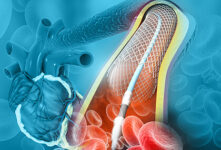Peripheral vascular disease is on the rise and peripheral PCI is at present the first choice of treatment for most patients. The use of IVUS in femoropopliteal territory has shown great benefits, especially in left main and complex PCI, reducing mortality and restenosis but, though promising, in lower limb ischemia we have little information as…
Stent Revascularization in Femoropopliteal Disease: An Analysis of Clustered Randomized Trials
A study compared pooled data of claudication and critical ischemia patients treated with stenting vs. by-pass surgery in femoropopliteal disease. The main objective of revascularization in femoropopliteal disease is to improve the quality of life and functional capacity of claudication patients who did not respond to medical treatment, and to save the affected limb in…
What Is the Best Strategy for Moderately Complex Femoropopliteal Lesions?
At present, PCI is the preferred treatment for femoropopliteal lesions and drug coated balloons (DCB) have shown good performance. However, they have not yet been shown superior to bare-metal stents (BMS). This study compared randomized trials IN.PACT SFA I/II and IN.PACT JAPAN including 288 patients vs. the prospective Complete SE and DURABILITY II with 483…
IVUS Use in Peripheral Vascular Disease: Should this Tool Be Used More Frequently in Peripheral Interventions?
Use of intravascular ultrasound (IVUS) has increased rapidly, and several randomized and observational studies have shown improved results in patients who underwent coronary angioplasty using this tool. However, evidence on IVUS on peripheral interventions is more limited. Observational studies have found similar benefits when IVUS was part of the revascularization strategy. In a meta-analysis of…
Drug Coated Balloons in Femoropopliteal Territory: Predictors of Failed Patency
Endovascular treatment in femoropopliteal territory has become the strategy of choice over time, with diverse devices; among others, drug coated balloons (DCB). DBS are meant to provide the antiproliferation effect of drugs while reducing exposure of a specific artery segment to a strange body. Even though the number of studies on DCB effectiveness has been…
Sept 28 – SOLACI@CACI@Grupo MIL Activity | Session on Peripheral Interventions: Making Peripheral Vascular Disease Visible
The Latin American Society of Interventional Cardiology (SOLAC) in conjunction with the Argentine College of Interventional Cardioangiologists (CACI) and the Group of Latin American Interventional Women (MIL) will hold a special day to make peripheral vascular disease more visible. The event will last 2 hours and a half and will be held in a hybrid…
Revascularization Using DES in Infrapopliteal Disease: Meta-Analysis and Change of Paradigm?
Peripheral vascular disease (PVD) has been under-studied and under-recognized in comparison with ischemic heart disease and stroke, despite its well-known impact on quality of life and its associated morbidity and mortality. According to a systematic review, it was estimated that in 2015 about 238 million people globally had PVD. This number is on the rise.…
One Year of Successful Carotid Artery Stenting with the CGuard Device
This registry of daily clinical practice suggests that this specifically designed double-mesh carotid stent is safe and associated with a minimal and acceptable occurrence of neurological events up to 12 months of follow-up. This double-mesh stent has already been tested, and its short- and long-term efficacy has been proven. However, more recent data have challenged the…
Discrepancy between Angina and Ischemia Repeats in Peripheral Artery Disease
Three randomized studies showed exercising significantly improves 6-minute walk outcomes in patients with peripheral artery disease (PAD). However, many participants randomized to exercise did not perceive changes, and sometimes even got worse. These findings suggest a significant discrepancy between objective and perceived change in walking ability among PAD patients. 400 patients with peripheral artery disease…
ELUVIA: DES in Complex Femoropopliteal Lesions
Paclitaxel-eluting stent Eluvia showed promising results after two years with a revascularization freedom rate of 80% despite the fact that these were complex femoropopliteal lesions. As the safety of paclitaxel-eluting devices becomes more consistent, more studies on its efficacy are being published. Back in 2018, the safety of paclitaxel-eluting balloons and stents was under scrutiny…









